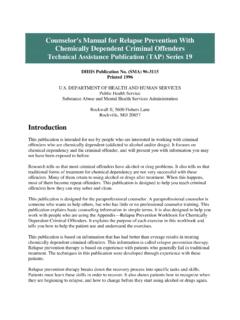Transcription of Providing Quality Family Planning Services
1 Providing Quality Family Planning Services Recommendations of CDC and the Office of Population AffairsContinuing Education Examination available at Recommendations and Reports / Vol. 63 / No. 4 April 25, 2014 Department of Health and Human ServicesCenters for Disease Control and PreventionMorbidity and Mortality Weekly ReportRecommendations and ReportsDisclosure of RelationshipCDC, our planners, content experts, and their spouses/partners wish to disclose that they have no financial interests or other relationships with the manufacturers of commercial products, suppliers of commercial Services , or commercial supporters. Planners have reviewed content to ensure there is no MMWR series of publications is published by the Center for Surveillance, Epidemiology, and Laboratory Services , Centers for Disease Control and Prevention (CDC), Department of Health and Human Services , Atlanta, GA Citation: [Author names; first three, then et al.]
2 , if more than six.] [Title]. MMWR 2014;63(No. RR-#):[inclusive page numbers].Centers for Disease Control and PreventionThomas R. Frieden, MD, MPH, Director Harold W. Jaffe, MD, MA, Associate Director for Science Joanne Cono, MD, ScM, Acting Director, Office of Science Quality Chesley L. Richards, MD, MPH, Deputy Director for Public Health Scientific ServicesMichael F. Iademarco, MD, MPH, Director, Center for Surveillance, Epidemiology, and Laboratory Services MMWR Editorial and Production Staff (Serials)John S. Moran, MD, MPH, Acting Editor-in-ChiefChristine G. Casey, MD, EditorTeresa F. Rutledge, Managing EditorDavid C. Johnson, Lead Technical Writer-EditorJeffrey D. Sokolow, MA, Project EditorMartha F. Boyd, Lead Visual Information SpecialistMaureen A. Leahy, Julia C. Martinroe, Stephen R. Spriggs, Terraye M. StarrVisual Information SpecialistsQuang M.
3 Doan, MBA, Phyllis H. KingInformation Technology SpecialistsMMWR Editorial BoardWilliam L. Roper, MD, MPH, Chapel Hill, NC, ChairmanMatthew L. Boulton, MD, MPH, Ann Arbor, MIVirginia A. Caine, MD, Indianapolis, INBarbara A. Ellis, PhD, MS, Atlanta, GAJonathan E. Fielding, MD, MPH, MBA, Los Angeles, CADavid W. Fleming, MD, Seattle, WAWilliam E. Halperin, MD, DrPH, MPH, Newark, NJKing K. Holmes, MD, PhD, Seattle, WATimothy F. Jones, MD, Nashville, TNRima F. Khabbaz, MD, Atlanta, GADennis G. Maki, MD, Madison, WIPatricia Quinlisk, MD, MPH, Des Moines, IAPatrick L. Remington, MD, MPH, Madison, WIWilliam Schaffner, MD, Nashville, TNCONTENTSI ntroduction ..1 Methods ..3 Contraceptive Services ..7 Pregnancy Testing and Counseling ..13 Clients Who Want to Become Pregnant ..14 Basic Infertility Services ..15 Preconception Health Services .
4 16 Sexually Transmitted Disease Services ..18 Related Preventive Health Services ..20 Summary of Recommendations for Providing Family Planning and Related Preventive Health Services ..21 Conducting Quality Improvement ..21 Conclusion ..25 Appendix A ..30 Appendix B ..35 Appendix C ..45 Appendix D ..47 Appendix and ReportsMMWR / April 25, 2014 / Vol. 63 / No. 4 1 Providing Quality Family Planning Services Recommendations of CDC and the Office of Population AffairsPrepared byLoretta Gavin, PhD,1 Susan Moskosky, MS,2 Marion Carter, PhD,1 Kathryn Curtis, PhD,1 Evelyn Glass, MSPH,2 Emily Godfrey, MD,1 Arik Marcell, MD,3 Nancy Mautone-Smith, MSW,2 Karen Pazol, PhD,1 Naomi Tepper, MD,1 Lauren Zapata, PhD11 Division of Reproductive Health, National Center for Chronic Disease Prevention and Health Promotion, CDC2 Office of Population Affairs, US Department of Health and Human Services , Rockville, Maryland3 The Johns Hopkins University and the Male Training Center for Family Planning and Reproductive Health, Baltimore, MarylandSummaryThis report provides recommendations developed collaboratively by CDC and the Office of Population Affairs (OPA)
5 Of the Department of Health and Human Services (HHS). The recommendations outline how to provide Quality Family Planning Services , which include contraceptive Services , pregnancy testing and counseling, helping clients achieve pregnancy, basic infertility Services , preconception health Services , and sexually transmitted disease Services . The primary audience for this report is all current or potential providers of Family Planning Services , including those working in service sites that are dedicated to Family Planning service delivery as well as private and public providers of more comprehensive primary United States continues to face substantial challenges to improving the reproductive health of the population. Nearly one half of all pregnancies are unintended, with more than 700,000 adolescents aged 15 19 years becoming pregnant each year and more than 300,000 giving birth.
6 One of eight pregnancies in the United States results in preterm birth, and infant mortality rates remain high compared with those of other developed report can assist primary care providers in offering Family Planning Services that will help women, men, and couples achieve their desired number and spacing of children and increase the likelihood that those children are born healthy. The report provides recommendations for how to help prevent and achieve pregnancy, emphasizes offering a full range of contraceptive methods for persons seeking to prevent pregnancy, highlights the special needs of adolescent clients, and encourages the use of the Family Planning visit to provide selected preventive health Services for women, in accordance with the recommendations for women issued by the Institute of Medicine and adopted by preparers: Loretta Gavin, PhD, Division of Reproductive Health, National Center for Chronic Disease Prevention and Health Promotion, CDC.
7 Telephone: 770-488-6284; E-mail: Susan Moskosky, MS, Office of Population Affairs, US Department of Health and Human Services . Telephone: 240-453-2818; E-mail: United States continues to face challenges to improving the reproductive health of the population. Nearly half (49%) of all pregnancies are unintended (1). Although adolescent birth rates declined by more than 61% during 1991 2012, the United States has one of the highest adolescent pregnancy rates in the developed world, with >700,000 adolescents aged 15 19 years becoming pregnant each year and >300,000 giving birth (2,3). Approximately one of eight pregnancies in the United States results in a preterm birth, and infant mortality rates remain high compared with other developed countries (3,4). Moreover, all of these outcomes affect racial and ethnic minority populations disproportionately (1 4).
8 Family Planning Services can help address these and other public health challenges by Providing education, counseling, and medical Services (5). Family Planning Services include the following: Providing contraception to help women and men plan and space births, prevent unintended pregnancies, and reduce the number of abortions; offering pregnancy testing and counseling; helping clients who want to conceive; Providing basic infertility Services ; Providing preconception health Services to improve infant and maternal outcomes and improve women s and men s health; and Providing sexually transmitted disease (STD) screening and treatment Services to prevent tubal infertility and improve the health of women, men, and report provides recommendations developed collaboratively by CDC and the Office of Population Affairs (OPA) of the Department of Health and Human Services (HHS).
9 The recommendations outline how to provide Family Planning Services by:Recommendations and Reports2 MMWR / April 25, 2014 / Vol. 63 / No. 4 defining a core set of Family Planning Services for women and men, describing how to provide contraceptive and other clinical Services , serve adolescents, and perform Quality improvements, and encouraging the use of the Family Planning visit to provide selected preventive health Services for women, in accordance with the recommendations for women issued by the Institute of Medicine (IOM) and adopted by HHS (6).The collaboration between CDC and OPA drew on the strengths of both agencies. CDC has a long-standing history of developing evidence-based recommendations for clinical care, and OPA s Title X Family Planning Program (7) has served as the national leader in direct Family Planning service delivery since the Title X program was established in report provides recommendations for Providing care to clients of reproductive age who are in need of Family Planning Services .
10 These recommendations are intended for all current or potential providers of Family Planning Services , including those funded by the Title X Context of Family Planning ServicesWomen of reproductive age often report that their Family Planning provider is also their usual source of health care (8). As the health-care system evolves in response to increased efforts to expand health insurance coverage, contain costs, and emphasize preventive care (9), providers of Family Planning Services will face new challenges and opportunities in care delivery. For example, they will have increased opportunities to serve new clients and to serve as gateways for their clients to other essential health-care Services . In addition, primary care and other providers who provide a range of health-care Services will be expected to integrate Family Planning Services for all persons of reproductive age, including those whose primary reason for their health-care visit might not be Family Planning .

















